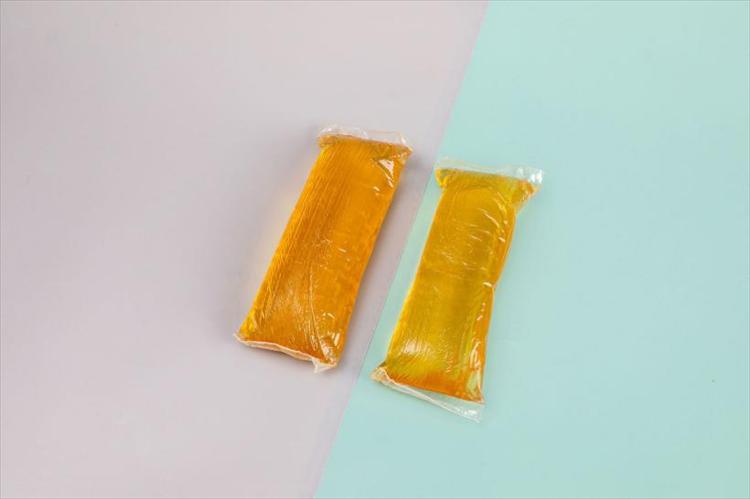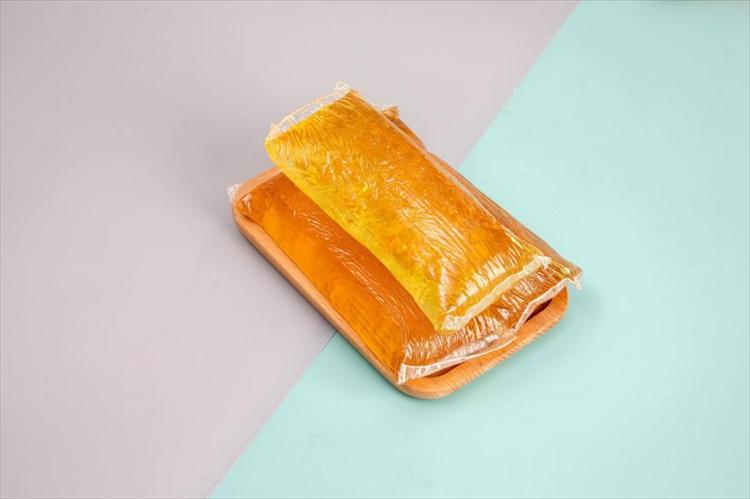Author:Baby & Adult Diaper Materials FROM:Diaper Materials Manufacturer TIME:2023-03-03
From the perspective of industrial application, this paper studies the reasons for the serious loss of viscosity of hot-melt pressure-sensitive adhesives for feminine hygiene products, and expects to find countermeasures to solve the problem, so as to provide a theoretical basis for the correct selection of hot-melt adhesives for hygiene products.

(1) Coating glue amount and peeling force
The bonding performance of hot melt glue is based on the viscoelasticity of its polymer chains: it should have a certain viscosity and flow to achieve good wetting of the substrate when used; at the same time, it must also have a certain elasticity , in order to produce suitable peel strength.
Factors such as the sizing process, formulation and characteristics of the breathable base film can all cause its loss of tack. By comparing the viscous sample and the normal sample, it can be obtained that the sizing amount of the viscous sample and the normal sample is not much different, and the squeegee is relatively uniform, indicating that the viscous sample can exclude the influence of the sizing process. The adhesion performance of the debonded samples at room temperature is poor, but under the conditions of 40 °C and 1.2 kg pressure, the simulated peel force is close to that of the normal samples.
(2) Color difference analysis of PE bottom film
After the test, it can be obtained that the color difference change rate of the viscous sample and the normal sample after sizing is very different. From this, it can be seen that the breathable bottom film has a great influence on its viscosity loss, that is, the loss of viscosity is caused by the joint action of it and the breathable bottom film.

(1) Influence of unfilled substrate
In order to further verify the influence of fillers in the bottom film of sanitary products on its performance, it was evenly coated on the PET film without fillers and without oil absorption, and the initial peeling force of the sample, the simulated peeling force, and the peeling after aging were tested. Its performance is measured by measuring its performance by measuring its use performance, such as annular initial viscosity at low temperature and normal temperature. The test results are as follows:
The adhesion performance of DMC-5255 and HM-D is better than that of Fuller1803; Fuller1803 also has good peel force on the PET base film, and its peel force drop after 14d aging is less than 10%, which can meet the requirements of use; different hot melt glue There is little difference in the initial adhesion of the three, indicating that all three have good pressure sensitivity.
To sum up, if several different hot melt adhesives are applied on the non-oil-absorbing PET base film, the adhesive performance of Fuller1803 is not much different from that of DMC-5255 and HM-D; Fuller1803/cotton is peeled off before and after aging The force drop is less than 10%, which is not easy to cause loss of viscosity. Therefore, its loss of viscosity is caused by its combined action with the breathable backing film.
(2) Influence of filler-containing substrates
Melt temperature before and after sizing of breathable base film
The unsized PE breathable bottom film has a crystalline melting endothermic peak at about 120 °C, while the crystalline melting endothermic peak of the breathable bottom film after sizing moves to a lower temperature direction.
Influence of substrates on their aging resistance and adhesive properties
Different hot melt glues were applied on the surfaces of the casting base film and the breathable base film respectively. Through experiments, it was found that the base material of the casting base film had little effect on its aging resistance and adhesive properties. The breathable base film has a great influence on its aging resistance and adhesion performance, and its initial peel force decreases with the aging time. When the aging time increases to 72h, its adhesion to the breathable base film tends to be stable; however, , After the aging of Fuller1803 type, its initial peeling force is less than 0.2N/cm (lower than the lower limit of use requirements), so the corresponding sample is prone to loss of viscosity.

The research results show that: the stability of hot melt glue and the bottom film is the most important factor causing its loss of viscosity; the filler and its content in the breathable bottom film have a great influence on its loss of viscosity; the difference between hot melt glue and standard cotton before and after aging The greater the change of the initial peel force, the more serious the migration of its low molecular weight auxiliaries to the base film, the more unstable its adhesive properties and the more prone to loss of viscosity.

 Email: info@whldiapernonwoven.com
Email: info@whldiapernonwoven.com
 MP/WhatsApp: +86-13599937366
MP/WhatsApp: +86-13599937366
 Manufacturer Address:Room 1105B, Bld M1, Manhattan, Yulongwan, Shimao, Shuanglong Road, Meiling Street, Jinjiang, Fujian, China
Manufacturer Address:Room 1105B, Bld M1, Manhattan, Yulongwan, Shimao, Shuanglong Road, Meiling Street, Jinjiang, Fujian, China